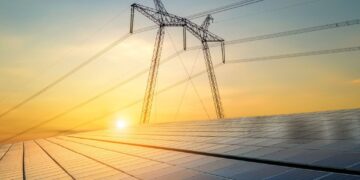Introduction
Planet Earth is warming rapidly due to a buildup of greenhouse gas (GHG) emissions, a negative externality from industrial sectors, food production systems, transportation systems, and status quo energy systems such as, hydrocarbon fuels, the burning of coal, oil, and natural gas for electricity and transport vehicles. The warming temperature is melting the polar ice shelves raising ocean levels, and threatening to inundate coastal cities. Oceans are absorbing exorbitant amounts of carbon dioxide (CO2), causing acidification of salt water that is killing off coral reefs and microorganisms, thus causing damage to the aquatic food chain. Rising ocean temperatures are creating inhabitable environments for certain species, diminishing their numbers, and causing survivors to migrate in search of better conditions. The warming oceans are changing global weather patterns and energizing storms into destructive events that carry greater amounts of rain and produce more forceful winds, all of which translate to increased damage to homes, businesses, and infrastructure in communities. The warmer air temperature is contributing to long-term droughts in some areas and more intense tornados and wind events in other areas. The product of a warming environment is increasingly inhospitable environments for humans, animals, plants, and microorganisms. Extreme weather events produce damage to edifices and infrastructure, disrupt global value chains for food supplies and energy fuels, thus negatively impacting economic development and market growth. Any combination of these externalities contributes to localized insecurity that catalyzes social disruption and even political conflict. This is a dire situation with no single tactic or strategy to mitigate harm and adapt to new environmental realities. Mitigation and adaptation approaches are context specific and localized. In recognition of these threats, the international community consolidated around the Paris Climate Change Agreement in 2015, where each country agreed to set NDCs, nationally determined contributions, to reduce GHG pollution with the aim of net-zero emissions by 2050.
Still, the global political economy is stressed. World leaders realized the need for a paradigm shift from status quo hydrocarbon energy systems to renewable, green, clean energy sources; yet vested interests obstruct progress where they can and the great expense of producing renewable energy sources to scale can be prohibitive in many national and local contexts. Therefore, the universally agreed net-zero emissions target by 2050 remains aspirational because the transition to renewable energy is sluggish.
This essay examines the progress of the United Nations (UN) Community of Parties (COP), the international community of nation-states, to combat climate change and bridge the gaps between status quo fossil fuels and renewable, clean energy production. It explores global progress to reduce GHG emissions since the 2015 UN Climate Change Conference, COP 21, where the landmark Paris Agreement was developed.
This essay has five sections. The first reviews the UN Sustainable Development Goal 7, To Ensure Access to Affordable, Reliable, Sustainable and Modern Energy for All. SDG 7 represents the ideal energy provision scenario for nation-states worldwide. Following that is a summary of the Paris Agreement and the obligations that nation-states and stakeholders agreed to deliver five years later at the COP 26, which was held in Glasgow, Scotland, in November 2021. At that point, a review of the outcomes from Glasgow is presented. A look at the developments from the previous two COP conferences will provide a sense of the commitments states have made ahead of the November 2022 COP 27 being held in Sharm el-Sheikh, Egypt. Ahead of COP 27, two reports were published that take the temperature, so to speak, of global efforts to reduce GHG emissions, the UN Environmental Programme (UNEP) released its Emissions Gap Report 2022 titled, The Closing Window: Climate crisis calls for rapid transformation of societies and the International Energy Agency’s (IEA) World Energy Outlook 2022 report. These two reports inform global progress on the transition to renewable and clean energies and the net-zero target. The final section looks ahead at the agenda for COP 27 and provides insight into expectations and likely outcomes.
United Nations’ Sustainable Development Goal #7
The United Nations’ Sustainable Development Goals are designed as a framework for nation-states, private enterprises, and civil society organizations to identify issues and act to increase equity among states and within societies, thus reducing insecurity and increasing individual agency across economic, political, social, and environmental sectors. Clean and reliable energy provision is a challenge for developing countries needing to finance infrastructure beyond urban areas and developed nations working to modernize electrical grids with renewable, green technologies as all countries drive toward a net-zero energy system. The following are the targets and indicators for SDG Goal 7:
ENSURE ACCESS O AFFORDABLE, RELIABLE, SUSAINABLE AND MODERN ENERGY FOR ALL
7.1 By 2030, ensure universal access to affordable, reliable, and modern energy services
7.1.1 Proportion of population with access to electricity
7.1.2 Proportion of population with primary reliance on clean fuels and technology
7.2 By 2030, increase substantially the share of renewable energy in the global energy mix
7.2.1 Renewable energy share in the total final energy consumption
7.3 By 2030, double the global rate of improvement in energy efficiency
7.3.1 Energy intensity measured in terms of primary energy and GDP
7.a By 2030, enhance international cooperation to facilitate access to clean energy research and technology, including renewable energy, energy efficiency, and advanced and cleaner fossil-fuel technology, and promote investment in energy infrastructure and clean energy technology.
7.a.1 International financial flows to developing countries in support of clean energy research and development and renewable energy production, including hybrid systems
7.b By 2030, expand infrastructure and upgrade technology for supplying modern and sustainable energy services for all in developing counties, in particular, least developed counties, small island developing states, and land-locked developing countries, in accordance with their respective programs of support
7.b.1 Installed renewable energy-generating capacity in developing countries (in watts per capita)
Sustainable development is a concept most often associated with middle- and low-income states; however, all states, even wealthy industrialized states, are at a developmental stage when considering the transition from hydrocarbon fuels to renewable, green, clean energy sources and the infrastructure necessary to operationalize them. Therefore, rather than exclude the global North in this analysis, it is pertinent to consider their industrial, energy security, and national infrastructure policies within the sustainable development framework. The climate crisis and the global transition to renewable, clean energy is a shared challenge for all countries, and COP negotiations seek to highlight the most affordable, accessible, and attractive sustainable solution options.
Paris Agreement, COP 21, 2015
The Paris Agreement is a legal binding international treaty for climate change action accepted by 196 Parties in December 2015. Article 2 of the Paris Agreement commits to holding the global average temperature well below 2 degrees Celsius above pre-industrial levels and encourages parties to pursue efforts to limit temperature increases to 1.5 degrees Celsius. Nation-states agreed to a gradual approach to peak greenhouse gas emissions globally, aiming to achieve net-zero emissions by 2050. The Paris Agreement is significant because it marks the first time the global community of states entered into a binding agreement and common cause to combat and adapt to climate change impacts.
Implementation of the Paris Agreement requires economic and social transformation based on the most reliable scientific evidence. Parties to the Agreement were obligated to submit their plans for climate action termed nationally determined contributions or NDCs ahead of COP 26 held in 2021. The NDC allows countries to communicate their strategy to reduce greenhouse gas emissions and meet the objectives of the Paris Agreement. States also present in the NDCs a description of plans of action to build resilience and adapt to the fallout from global temperature rise.
The Parties developed a general framework for financial, technical, and capacity-building support for at-risk countries with smaller economies. Blocks of developing countries highlighted during negotiations that the ‘polluter must pay’ principle applies, thus placing the onus for financing climate action in the global South on industrial countries of the North. Financial support targets mitigation measures and approaches to adaptation, both requiring major investment. Parties also advanced the idea of partnerships for technology development and transfer to improve climate change resilience and GHG emissions reduction. A technology framework was devised to give guidance for using the Technology Mechanism, which facilitates technology development and transfers through the diffusion of policy and implementation approaches. In tandem with technology transfer, the Agreement emphasizes climate-related capacity-building for developing countries and obligates developed countries to commit. In short, the Paris Agreement offers an improved framework for multi- and bilateral cooperation. Still, its ultimate success or failure rests on a plethora of essential actions and policy changes in every country and society on Earth.
Three significant shifts in political dynamics explain why the Paris Agreement negotiations were perceived as successful. First, the Paris Agreement moved from a strict top-down regulatory model to one that seeks bottom-up progressive and facilitative actions. COP 21 adopted the “pledge and review system” first introduced during the Copenhagen negotiations. The second major shift in political dynamics resulted from embracing subnational and nonstate entities as catalysts for action and change. Since the early 2000s, cities, state and municipal governments, firms, trade associations, and civil society organizations have supported climate change action, advancing progress during periods of gridlock in multilateral negotiations. Third, the largest emitter of GHG emissions since the mid-2000s, China, participated unlike in the past. They asserted to become a global leader on climate change and this was reflected in the adoption of reduced energy and carbon intensity targets in its twelfth Five-Year Plan (2011–2015).
Glasgow Climate Pact, COP 26, 2021
The Paris Agreement of 2015 provided nation-states five years to study their national contribution to GHG emissions and establish their NDCs – Nationally Determined Contributions – to step down emissions totals ahead of the 2021 COP 26 in Glasgow, Scotland. The stated aim of the United Kingdom Presidency over COP 26 was to “keep alive the hope of limiting the rise in global temperature to 1.5C.” On paper, this goal is achieved; however, the reality is that governments and private entities are falling short of their pledges. This, combined with the global disruptions to the energy supply chain resulting from Russia’s war on Ukraine, has left a yawning gap between NDC implementation and Paris Agreement targets.
Emerging from the negotiations at COP 26 are four areas of strategic focus, (i) mitigation – reducing GHG emissions, (ii) adaptation – assisting those already experiencing climate change impacts, (iii) finance – enabling countries to deliver on their climate goals. However, it is important to point out that developing states took a firm position on the demand for financial assistance from industrialized states that have, from their perspective, instigated the problem and caused the crisis. Since the mid-19th century, industrialized nations have indiscriminately pumped industrial pollutants into the atmosphere while reaping the economic benefits. The finance debate informs and encourages (iv) collaboration – states working together to deliver compounding action.
A smattering of deliverables that came out of COP 27 includes: commitments of over $20 billion from international partners focused on a just and inclusive transition from coal to clean energy. Developed countries made progress towards delivering on their $100 billion climate finance goal that was set at COP 21, now expected to be reached by 2023; and, several additional climate finance announcements from developed countries were made such as the Champions Group on Adaptation Finance, the initiation of the Taskforce on Access to Climate Finance, and a new financing scheme, Capital Markets Mechanism among others. Additionally, states and corporations made extensive commitments to speed up the transition to electric vehicles. Governance breakthroughs also manifest, such as the finalization of the Paris Rulebook, production of detailed tables for the Enhanced Transparency Framework to synchronize a common approach to tracking and communicating state emissions, support, and action, and 40 countries accounting for 70% of global GDP endorsed the Breakthrough Agenda where they commit to working together to make clean and sustainable solutions the most affordable, accessible, and attractive option in each of the emitting sectors before the end of this decade.
The Emissions Gap Report and The World Energy Outlook Analysis
COP 21 produced the Paris Agreement bringing the climate change crisis to the fore as a threat to societies everywhere. Plus, it highlighted the importance of focused, global cooperation to bolster mitigation, adaptation, financing, and cooperation along the value chain of climate crisis interventions. The Paris Agreement represents the acknowledgement by countries that the reduction of GHG emissions is necessary and that falling short of 2030 and 2050 targets will increase global temperature far beyond the ideal 1.5C and the acceptable 2.0C increases. COP 26 was an opportunity to build upon the Paris framework and evaluate national NDCs. The results were mixed. There was some progress made in harmonizing the regulations for tracking progress. Pledges of financial contributions to a variety of programs were increased, most salient of those support resilience in developing economies. Progress toward net-zero emissions was insufficient due in part to incomplete NDC plans by some countries, and the crisis response to the global energy crisis produced by the Russia-Ukraine War. To better understand the situation aimed at limiting global temperature rise to below 2.0C, we can look to recent reports by the International Energy Association (IEA) World Energy Report 2022 and the United Nations Environmental Programme (UNEP) Emissions Gap Report 2022.
It should not surprise anyone that UNEP claims “[T]he planet is currently facing a triple planetary crisis of climate change, pollution, and biodiversity loss.” These crises are exacerbated by compounding energy, food, and cost of living crises brought on by the Russian-Ukraine War. The report highlights the gap between existing NDCs and what is necessary to meet international targets. Analytical models suggest that existing (global) policies indicate a 2.8C increase by 2100, and the best-case scenario of full implementation of conditional NDCs combined with additional net-zero commitments could produce around a 1.8-degree rise in global temperature. To stave off the worst climate change impacts, the world must cut 45% of current GHG emissions in eight years by 2030 to limit warming to 1.5C. A graduated approach is no longer feasible. A System-wide transformation is necessary, which means reforms in the electricity supply chain, industrial processes, transport systems, building construction, and the food system.
The Covid-19 pandemic had one extenuating positive outcome; the global shutdown of the economy produced a 4.7% drop in total global GHG emissions over the 2019-20 period. This is the largest single-year drop in GHG emissions since the data began in 1970 (Dhakal et al. 20221). The IEA report adds to this picture. Energy-related and industrial process CO2 emissions rebounded by 1.9 gigatons in 2021, the largest ever annual rise in global emissions levels recorded at 36.6 Gts.
Identifying the largest emitters of GHG is useful for assessing the situation and planning developments. The states leading the world in GHG emissions are China, the EU27, India, Indonesia, Brazil, the Russian Federation, and the United States. An overview of the G20 reveals that the collective is responsible for 75% of global GHG emissions. Yet, G20 countries are currently not meeting their NDC commitments for 2030. Still, across the entire global community, 86 parties responsible for 79% of global GHG emissions have now adopted net-zero targets either in law (21), in a policy document (the NDC or long-term strategy paper) (47), or in an announcement by a high-level government official (20). Of the G20 members, 19 have committed to achieving net-zero targets.
The African continent holds approximately one-fifth of the world’s population and is experiencing severe climate change impacts despite producing merely 3 percent of global energy-related carbon dioxide emissions, the lowest rate of emissions per capita of any region. Fifty-three countries, more than half of the continent, have produced a National Determined Contribution (NDC) mitigating a total of 550 Mt of CO2 by 2030. This equates to 40 percent of Africa’s current emissions. Twelve African countries have announced net-zero emissions goals. Yet, many African NDCs are conditioned on financial support from developed countries (Africa Energy Outlook 2022 – Analysis – IEA).
In some cases, UNEP makes allowances for the lack of pacesetting and backsliding due to the risk created by Russia’s invasion of Ukraine and the reverberating implications it produces. Nonetheless, they challenge governments with a choice related to climate change. Governments can either (a) use the current Russian-created energy crisis as an opening to accelerate the transition away from fossil fuels and increase the application of renewable energies plus, expanding energy conservation strategies and efficiency standards, or (b) governments can choose to divert attention away from climate change action and pursue continued investment in fossil fuel projects locking-in the status quo for an indeterminant duration and undermining the Paris Agreement GHG emissions targets.
1 Dhakal, S., Minx, J.C., Toth, F.L., Abdel-Aziz, A., Meza, M.J.F., Hubacek, K., Jonckheere, I.G.C. et al. (2022). Chapter 2: Emissions trends and drivers. In Climate Change 2022: Mitigation of Climate Change. Working Group III Contribution to the Sixth Assessment Report of the Intergovernmental Panel on Climate Change. Intergovernmental Panel on Climate Change. Geneva. https://www.ipcc.ch/report/ar6/wg3/downloads/ report/IPCC_AR6_WGIII_Chapter_02.pdf.
Both the UNEP and IEA reports (UNEP 2022, 52; IEA 2022, 30) highlight the threat of exceeding 2.0C temperature rise by 2100 and inform that current policy action may not be enough to achieve the Paris Agreement goals. The IEA highlights state policy interventions that are perceived as leading toward Paris Agreement goals. For instance, the United States Congress passed the Inflation Reduction Act (IRA) (2022), which increases solar and wind capacity to two and a half times above current levels and will spur the adoption of electric vehicle purchases and other green energy technologies through consumer rebates. IRA 2022 provides $370 billion for energy security and climate change investments. China currently leads the world in investments in renewables and electric vehicle (EV) sales as it continues to expand its clean energy infrastructure. This effort could cause Chinese coal and oil consumption to peak before the end of the 2020s. The European Union, spurred on by Russia’s manipulation of energy supply, is directing significant resources to increase efficiency and build out renewable energy infrastructure.
Ahead of Sham el-Sheikh, COP 27, 2022 and beyond
increase by 2050 in relation to pre-industrial levels. Egypt’s COP 27 presidency vision is to prioritize implementation. Negotiations and planning have taken priority at the Paris Agreement and prior conferences. Today, the situation demands that Parties harmonize a concerted global effort to move rapidly towards full, timely, inclusive, and at-scale climate action on the ground. The evidence is clear that the climate crisis will continue to aggravate social, economic, and environmental threats.
The goals for COP 27 are not new ones but aim to generate action on the four tents of the COP process, mitigation, adaptation, finance, and collaboration. This is an opportunity for countries to deliver on their pledges and commitments to operationalize the four interdependent actions just mentioned. The overall goal is to implement the Paris Agreement and the Glasgow Pact, review NDCs and develop working programs to operationalize multi- and bi-lateral partnerships on mitigation, adaptation, finance, and collaboration efforts aimed at transforming global systems of industrial production, food production, transportation, construction, and electric power provision.
Reflecting on the development of the global environmental regime from the historic Paris Agreement to today, seven years later, we see developments to transition from the status quo global hydrocarbon-driven economy have progressed incrementally. Now, the IEA and UNEP raise an alarm that drastic reductions in GHG emissions must take place immediately and ramp up over the next eight years ahead of 2030, then continue to expand to 2050 to maintain the acceptable 2.0C or less target.
The thing that I will be watching at COP 27 in Sharm el-Sheikh is an acknowledgement of the urgency in the form of focused collective action. Industrialized states from the global North must fuel the energy transition to renewables and best practices in mitigation and adaptation at home and with financial transfers to developing countries for investment in renewable, green, clean technologies. Yet, market forces are volatile, and inflation is creating economic insecurity in the South as well as the North making it more expensive to fund climate change interventions.
Unfortunately, the community of nation-states is trending not toward closer relations and cooperation among countries but rather taking up defensive postures. The era of globalization has ended, and aspects of interdependent global value chains are fracturing. A major catalyst is the increased geopolitical competition between the two nations with the largest national economies, China and the United States. Trade tensions between the two have exacerbated security concerns on both sides. One major tipping point is the independent status of Taiwan, where China insists the island is Chinese territory, and the US supports Taipei’s democratic government’s intention to operate independently of Beijing. Then there is Russia’s invasion of Ukraine which has brought war to the European continent for the first time since World War II. This war has divided eastern and western regions, which has produced a groundswell, yet tenuous, coalition of support by the West behind Ukraine.
Furthermore, democratic institutions in countries across the globe, including in western Europe and North America, the bastions of democracy, are under attack and either stressed or crumbling under the weight of isolationist nationalism and the emergence of authoritarian-leaning leadership. These dynamics undermine the liberal institutionalism that the United Nations and other multilateral institutions rely upon to produce consensus and peaceful resolution to conflict. In a time of global crisis, the world order is regressing to the conceptualization of an anarchic world order populated by self-interested rational actors working to maximize power and control of resources. This trend is problematic for progress at COP 27; political and ideological differences must be sidelined while truly rational action is taken to reduce global temperature change.
When the existential threat crosses over into a probable-to-definite threat, you would think that rational actors would set aside differences and prioritize collaboration to extinguish the mutual threat. The global environmental regime has been doggedly debating and negotiating a balanced approach between economic growth and environmental sustainability for 50 years. COP 27 is where these dedicated actors hope to accelerate action to reduce GHG emissions and environmental degradation. Yet as indicated in the UNEP and IEA reports, incrementalism toward climate action goals is insufficient to protect from the worst of the climate change impacts. The Egyptian presidency’s vision claims that the time for negotiation is over, and now it is time for collective national action. A sustainable development approach is the answer, and the Parties understand this, but whether they will act in self-interest or collective interest is yet to be revealed.













